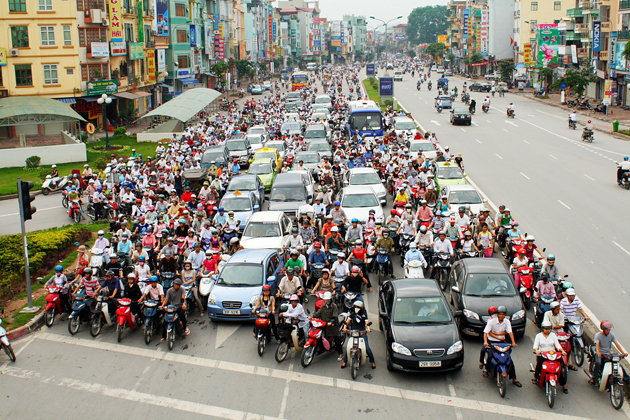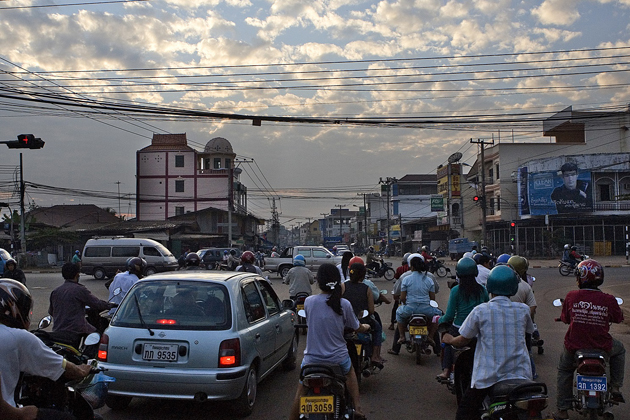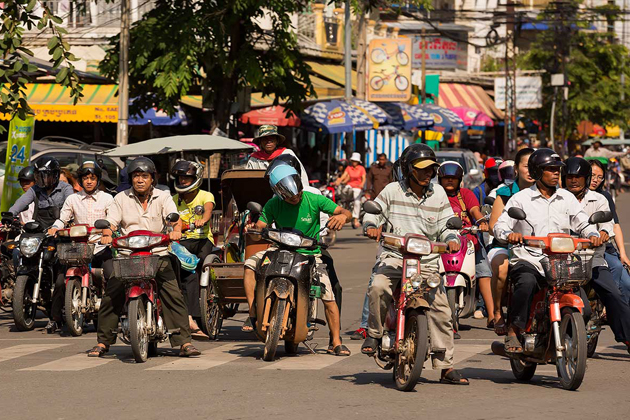Besides the concern about Internet access, accommodation booking and water and hygiene in the destinations, the current matter in question is turned over in all tourists’ mind is the traffic system in the Indochinese peninsula. The systems of traffic of 3 countries are featured by unique and unmistakable characteristics which will stay in travelers’ mind for all their lifetime.
In Vietnam
One thing should surprise sightseers when touring Vietnam is the dense density of motorbikes in the roads like an ant’s nest. Vietnam has long known as the country with most motorcycle users in the world. Vietnamese system of traffic still remain several inadequacies which can slightly bore travelers to death when traveling Vietnam. It is inconsequential to move around the country in 12 pm or 5h30 pm because traffic jams during peak hours in big cities are common in Vietnam. Conversely, the problem seems to be better in the countryside or remote areas.
The main means of transportation in Vietnam are motorcycles, cars; other vehicles includes cyclo, taxi, carriage, train, bus etc. What also makes Vietnamese traffic system unique is there are many motorcycle taxi drivers use motorbike branded Dream, Wave, Sirius and Jupiter to carry passengers regardless of day and night.
Crossing the road in Vietnam is like ‘an impossible mission’ to sightseers, and it becomes a long-lasting nightmare toward tourists. People should be always conscious to cross the road immediately after seeing the red light signals because if you even miss a second, you will be trapped in dozens of big vehicles racing forward and have to wait for 99 more seconds for successful road-crossing. Sightseers had better go over the road with the help of local people or travel by buses or taxis to comfortably enjoy the fascinating sceneries and busy streets without any worry.

In Laos
There are some similarities in transportation systems in some cities in Laos and Thailand. Private cars and Tuk tuk are popularly used in Laos. Motorcycles using is not as much as that of Vietnam. Public transport in Laos is a variety of shapes and sizes from passenger cars, buses, taxis, etc. However, hiring a taxi to sightsee the country all day long is unpopular. You can count the number of driving taxis by your fingers. Instead of modern vehicles, tourists often enjoy touring around beautiful Laos in expensive but awesome Tuk Tuk.
The traffic system in Laos is still incomplete with a few options of public transport. The Laos streets are full of cars from Korean mid-range brands involving Kia or Hyundai or others means of transportation such as motorcycles, homemade cars and outdated coaches. Surprisingly, with that large number of circulating machines for transportation, rarely do visitors hear the horns in almost streets of Vientiane. Horns are used in special cases such as accidents; hence, sounding the horns when traveling in Laos as a luxury thing to experience.
It is warned that you should be careful to move in the small to large roads because the vehicles running straightly on the main road are preferred and the drivers always run considerably speedily. Assure that no car is run after you before road-crossing.

In Cambodia
It is unique in in the middle of Vientiane, visitors can encounter dozens of local people sitting in the truck roofs or bodies. The street is filled with not only luxurious cars but also cars without license-number. Moreover, it is easy to catch the image of cars stacked tightly with workers in rush hours in Cambodian streets and the same situation happens with smaller motors including agri-motors and tillers. Local people pointed out that moving around like that is more money-saving and safer, so this habit becomes cultural feature in Laos.
The streets in Phnom Penh are suffused of countless antique motorcycles without license-number. To shortly get into the corner of the city, rent "xe om" (motorbike taxis) for 1,500 - 4,000 Riel per tour, or 6-8 USD per day. In Phnom Penh, parking space for cars, motorbikes, tuk tuks, pedicabs can be everywhere. Cars are preferred to be parked on the roadside.
Classic taxi is not extremely well-known in Cambodia. In big cities, taking a taxi at some hotels or restaurants is effortless. More common forms of public transportation is motorcycles, automatic trailers and rickshaws. To Siem Reap, the city of Angkor temples, you will be surrounded by more crowded tuk tuk drivers than in any other Cambodian city. They are always willing to take you on the pleasant trip all day long with the affordable price.


